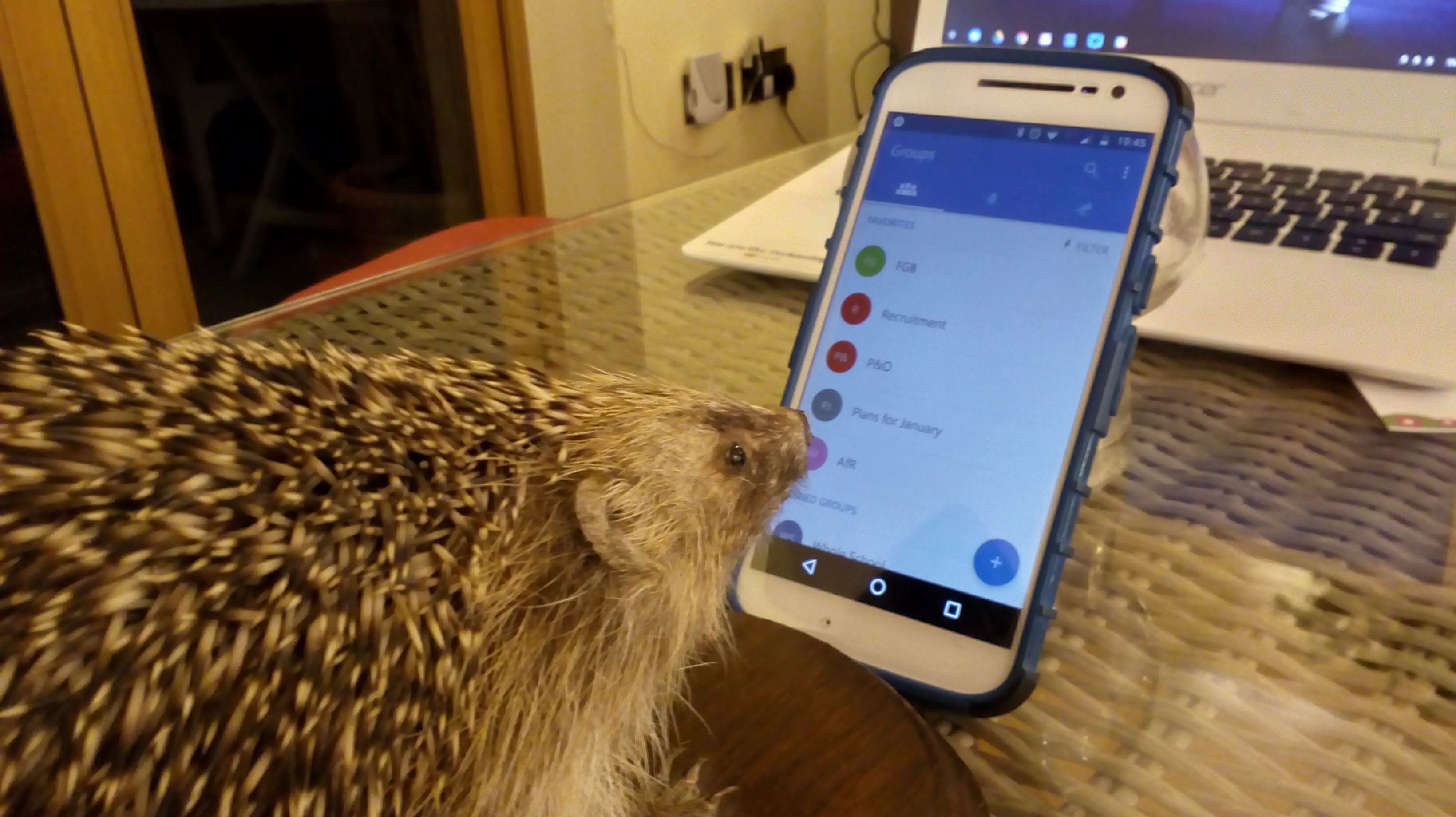
Photo by me. Hedgehog provided by @hedgehoghugh CC BY-SA
School governors are a bit like hedgehogs. Our activity is mostly misunderstood, we can have a much bigger impact on the world than you might think, and we are busiest at night.
Stretching this simile even further (with apologies to the Hugh Warwick, stand-up ecologist, author, and friend to both hedgehogs and Ezekiels) I fear that, unless governors adapt and evolve faster than our snuffling friends, we too will become endangered and squished by passing technology and Policy! For those also looking for a way to survive, I think we’ve found an adaptation that works for us, and might work for you.*
Post Summary:
Through using digital tools in the cloud, governance at Larkrise Primary School has been made more effective and easier to manage. Though we’d recommend it, this is not about the technology, but about a shift in culture. There is more we could do and would love to connect with others using similar approaches.
Post in Full:
Why change?
It has been a year since I wrote about our plan to evolve and adapt to improve governance at Larkrise Primary School, and our reasons for choosing MS Office 365 (O365) as our platform. We moved to O365 to tackle major issues with using Google Drive as an ad-hoc document store, including: eSafety/confidentiality for governors; better administration/coordination with our clerk and between committees; improved communication with SLT; and better integration with staff tools.
What did we do?
We set up Groups for each committee, (this was before Teams had been fully developed in O365), with a similar structure in each, using common language – giving all governors introductions and access to all areas and to all the services. I ran a series of sessions modelling and enabling live collaboration in writing and commenting on documents. Chairs of committees, including Chair of Governors, modelled failing and persisting with O365, and asked SLT to share on the cloud rather than emails or hard copies. This forced a major change in behaviour and quickly improved communication between staff and governors, reducing misunderstandings and reducing workload.
Where are we now?
As 2017 closes, we now have all committee papers (agendas, minutes, reports, data) posted before meetings, with invitations to review, comment and edit. All three of our committees work more effectively through working online, asynchronously and face-to-face. Our excellent clerk makes great use of the calendar, conversation threads and prompts us into action!
As many of you know, the really detailed, hard work of governors happens throughout the year, not just at Full Governing Body (FGB) meetings. We work on governor business when we can, before work, at a stolen moment during the day, and after the kids have gone to bed. We reflect this reality by doing and recording all this work in O365 – spreading out our effort to when it suits us.
Why should you try this?
The benefits are clear:
- Committee meetings are shorter (if not short!)
- There are very few emails, and even less paper to deal with
- Governors can work when they want, as much as they want to
- Instead of being reactive in meetings, governors and SLT can be proactive in following up areas for discussion, and bring solutions.
- Governors feel better able to hold SLT to account and support the school more effectively
- SLT can manage governor expectations in a timely and appropriate fashion
- Everything is in one place and easier for everyone to find
- Communication between governors and with SLT has improved enormously
- Our work is not in silos, and transparency makes for more joined up strategic overview
Who else benefits?
We’ve done this to help ourselves, the SLT and the children and staff we work with. It has helped build trust with our staff and SLT – and to model better use of technology for professional use. However, we are accountable too, and were we to be inspected by Ofsted they would see that much of the activity of our governing body now takes place on O365.
- They would be able to find all our minutes, committee reports and related files easily – and we can share those files instantly and securely.
- They would see a back and forth in comments on documents from SLT, where governors regularly challenge and hold SLT to account.
- They would see informed, focussed discussions, and clear delegation and agenda building for future meetings.
- They would see visit reports, budget adjustments checked, policies updated, curriculum discussions, staff feedback discussed, strategic plans adapted, research and blog posts shared, and the discussion around the local / national picture, with analysis for our school context.
- They would see minutes noting online discussions, and agenda items linked to specific documents.
- They would see a changing pattern in our meetings through 2017; from 1½ hours of line-by-line discussion of headteacher reports, to 30 mins on the main issues from reports and far more time on the living reality of school life and the challenges of doing right by more of our children.
- They would see us discussing the context and implications of the data, rather than the data itself. We have the time to learn about the children behind the numbers and adjust our strategic work accordingly.
The choice is not whether to join us on this journey – but how you do it! For us, as a highly skilled and involved governing body, using O365 was likely to work well. I would like to say that it can work for all governing bodies, …
…but….
…it’s not all been plain sailing. The most obvious and predictable problem was that not all governors have found it easy to get on with the technology. For some, this was using cloud tools for the first time and O365 is a lot less intuitive than Google, as it often wants to link to local drives/apps. For others, it was a matter of adding another MS login to their work/personal setup. And,…yes… we had some people who struggled to get to grips with digital tools at all!

CC0 https://pixabay.com/photo-248827/
Don’t expect everyone to get on the bus straight away. Governor are all volunteers and cannot be compelled to do anything. Expect to share screens, email some attachments, and print documents for those who are not ready for the shift yet.
That said, even when we were still using email and printed documents to meetings, there were lots of problems, with people not getting documents in advance, emails not getting through, wrong versions being reviewed, and people feeling that their contribution was lost in the discussion. So, while depending on technology has issues – I’d argue that the benefits outweigh the status quo!
There were concerns that this would increase workload – and, in the early months of the shift – it is fair to say that governors did not always get the balance right, and expected too much of SLT in responding to questions or requests that often crossed into operational matters. I’d love to say we’ve learned all those lessons, but it’s an evolving area and one we hope to establish new, clearer boundaries with our new headteacher and school business manager.
However, we have had feedback that SLT have found that, by being able to dampen small concerns as they come up, or manage expectations before they grow, overall workload managing governors has reduced. Quite often, governors will answer each others questions on O365, or point each other to documents already shared- thereby saving SLT time and communication worries.
This is about more than technology platforms. Crucially, this is a shift towards sharing, collaboration and openness – and requires a shift in culture – but not in the actual work!
Before setting off on this journey it is essential to make sure that everyone is clear that, though the practice of governance will change, the principles of good governance and your school / organisational values must be defended.
O365 might work for you, but you might also want to look at whether Google Apps for Education is a better fit; or consider project team tools like Basecamp, or specific services, like Slack for discussion, or Trello for task management.
Where might this lead?

(C) All rights reserved Hugh Warwick – used with permission and thanks https://flic.kr/p/RpA5rG
Once governing bodies have discovered the benefits of using digital tools, they open tantalising and/or terrifying doors to transforming school governance forever; to better reflect our digitally enhanced society and to better serve our communities and/or to expose the delicate thread separating operational and strategic decisions to an onslaught of blunt assaults.
Personally, I’d like to see how digital engagement tools such as Loomio, which allow groups of people to make decisions together, could improve the way governors represent the school community better.
I realise that this is heresy for many governors as it challenges the principle of governance through representative democracy (you elect me because you trust me to make good choices) rather than direct democracy (your vote counts on each issue – like a referendum). I am not sure giving a direct vote on uniform or homework should lead to a change in school policies – but unless we trust children, parents and staff to express their views into the governance of the school, through appropriate and managed channels, then are we really doing all we can do reflect the school community?
Yes, it will mean that we might have to explain ourselves better and it might lead to more open discussions than are required right now. Yes, there is a risk of the Brexiteer/Remoaner type factions emerging – but schools are public bodies and we have a duty to deal with difficult issues responsibly and transparently. People often suggest that academy governance are less accountable than maintained schools – so those of us not in academy structures should do more to be more representative and accountable to our communities.
We should explore, experiment and engage with technology to improve the work we do, cope with the complexity and rise to the challenge, and put our school values and the best possible outcomes for our children first.
You know what happened to the hedgehog who crossed the road? She got to the other side.
*These are very much my views and though it has been shared with staff and governors, does not represent the official view of the Larkrise Primary School Governing body or staff.

Pingback: Reflections on digital governance - Modern Governor